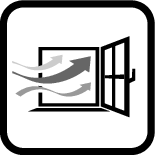Safety instructions

Read all the safety information and instructions. Failure to observe the safety information and follow instructions may result in electric shock, fire and/or serious injury.
Save all warnings and instructions for future reference.
- This heat gun is not intended for use by children or persons with physical, sensory or mental limitations or a lack of experience or knowledge. This heat gun can be used by children aged 8 or older and by persons who have physical, sensory or mental limitations or a lack of experience or knowledge if a person responsible for their safety supervises them or has instructed them in the safe operation of the heat gun and they understand the associated dangers. Otherwise there is a risk of operating errors and injury.
- Supervise children during use, cleaning and maintenance. This will ensure that children do not play with the heat gun.
- Handle the heat gun with care. The heat gun produces intense heat which increases the risk of fire and explosion.
- Take particular care when working in the vicinity of flammable materials. The hot airflow or hot nozzle may ignite dust or gases.
- Do not work with the heat gun in potentially explosive areas.
- Do not aim the hot airflow at the same area for prolonged periods. Working with plastic, paint, varnish or similar materials may produce easily flammable gases.
- Please be aware that heat is directed to covered flammable materials, which may ignite.
- Safely place the heat gun on the storage surfaces after use and let it cool completely before packing it away. The hot nozzle can cause damage.
- Do not let children use the heat gun unsupervised when it is switched on.
- Store idle heat guns out of the reach of children. Do not allow persons unfamiliar with the heat gun or these instructions to operate the tool. Heat guns can be dangerous in the hands of untrained users.
- Do not expose the heat gun to rain or wet conditions. Water entering a heat gun increases the risk of electric shock.
- Always wear safety goggles. Safety goggles reduce the risk of injury.
- Remove the rechargeable battery before adjusting the tool settings, changing accessories, or storing the heat gun. This safety measure prevents the heat gun from being started accidentally.

Keep your work area well-ventilated. The gas and steam produced during work are often harmful to one's health.
- Wear protective gloves and do not touch the nozzle while it is hot. There is a risk of burns.
- Do not direct the airflow at persons or animals.
- Do not use the heat gun as a hair dryer. The outgoing airflow is considerably hotter than that of a hair dryer.
- Do not allow foreign objects to enter the heat gun.
- The distance between the nozzle and the workpiece depends on the material you are working on (metal, plastic, etc.) and the intended working method. Always test the amount of air and temperature first.
- Do not open the battery. There is a risk of short-circuiting.
- In case of damage and improper use of the battery, vapours may be emitted. The battery can set alight or explode. Ensure the area is well ventilated and seek medical attention should you experience any adverse effects. The vapours may irritate the respiratory system.
- If used incorrectly or if the battery is damaged, flammable liquid may be ejected from the battery. Contact with this liquid should be avoided. If contact accidentally occurs, rinse off with water. If the liquid comes into contact with your eyes, seek additional medical attention. Liquid ejected from the battery may cause irritation or burns.
- The battery can be damaged by pointed objects such as nails or screwdrivers or by force applied externally. An internal short circuit may occur, causing the battery to burn, smoke, explode or overheat.
- When the battery is not in use, keep it away from paper clips, coins, keys, nails, screws or other small metal objects that could make a connection from one terminal to another. A short circuit between the battery terminals may cause burns or a fire.
- Only use the battery with products from the manufacturer. This is the only way in which you can protect the battery against dangerous overload.
- Only charge the batteries using chargers recommended by the manufacturer. A charger that is suitable for one type of battery may pose a fire risk when used with a different battery.
| Protect the battery against heat, e.g. against continuous intense sunlight, fire, dirt, water and moisture. There is a risk of explosion and short-circuiting. |
